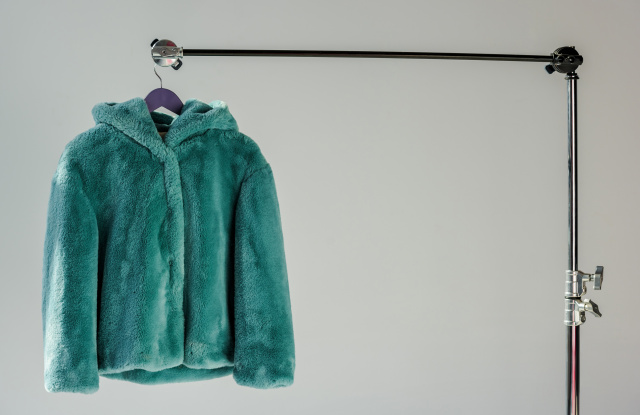Is There a Difference Between Faux Fur and Vegan Fur? – WWD
First there was faux fur. Now vegan fur has entered the fray.
And in a world rife with eco-labels and greenwashing, it’s worth unpacking the difference in definition and impact when it comes to faux fur and its varieties.
In short, according to experts, there’s little material difference between the two, though vegan fur may be more aligned with the trending sustainability lingo and what today’s consumers are connecting with.
“In the substance there is no difference between vegan fur or faux fur. They are the same animal-free materials,” said Arnaud Brunois, communications manager for high-end faux-fur developer Ecopel, which counts Stella McCartney and Kering among its clientele. “I would say that the term ‘vegan’ has been more recently accepted by fashion brands, while at the beginning, vegan materials were considered as something mysterious only restricted to vegans…The term vegan fur is probably more adapted to Gen Z.”
Largely, faux versus vegan fur is a matter of branding, though there are some nuances.
As Liesl Truscott, director of Europe and materials strategy for sustainability focused nonprofit Textile Exchange, said, “In simplistic terms, ‘vegan’ refers to products that exclude animals (derived from and/or tested on) and the term ‘faux’ refers to an artificial or synthetic alternative. Using these definitions, the same product can be marketed as either faux or vegan-friendly.”
Either way, as vegan fashion continues to see greater appeal among a cohort of increasingly conscious consumers, and fashion houses and brands continue to shirk using animal hides in their products, the market for fur that forgoes animals is expected to see continued growth.
According to a report by global research firm Technavio last year, the faux-fur market should see a compound annual growth rate of more than 19 percent between 2019 and 2023. And if faux-fur producers can move to more sustainable materials, analysts said that could further impact market growth, too.
The bigger factor to focus on, beyond whether to label fur “faux” or “vegan,” is its impact.
Traditionally, faux fur has been made from synthetic fibers, which, because these fibers are derived from fossil fuels and often shed microplastics, they’ve tapered off in favor among those pushing for greener materials. And that has begged the questions: is faux fur sustainable?
The answer is manifold and, in some ways, complex.
“Some faux fur may be made from recycled inputs, which helps address the negative effects from the petrochemical industry, while doing nothing to address the effects of microplastics. Similarly, bio-based faux fur, which some may refer to as vegan fur, may reduce the reliance on petrochemical inputs, although not necessarily entirely. Bio-based does not inherently mean that the fibers are biodegradable, and depending on the type of bio-based production methodology, they can also produce microfibers that are toxic to aquatic life,” Truscott explained. “Bio-based fibers produced from corn, sugarcane, or other agricultural feedstocks may also come with the associated impacts of crop production such as fertilizer, pesticides, water and land use. In this sense, bio-based faux fur is highly dependent on the unique producer and supply chain. While not directly linked to issues of animal rights, both petroleum and plant-based faux fur can have adverse effects on animals and ecosystems through microfiber shedding and chemical use.”
There won’t be one faux fur solution that’s wholly sustainable, but companies like Ecopel are working to advance the material in that direction.
The company has developed a bio-based faux fur dubbed KOBA, which it sources from DuPont and says is 37 percent plant-based, derived from corn byproduct. As Brunois explained, Ecopel is able to develop KOBA using 30 percent less energy and 63 percent fewer greenhouse gas emissions.
“It is a greener synthetic with a reduced impact on the environment compared with classic synthetics,” he said. “Pressure for action has been growing and many stakeholders in the textile industry have started a journey to become more responsible and more sustainable. Brands are asking for better practices from suppliers, which is great. Synthetic fur, like all materials, has a burden on the environment that cannot be denied.”
While no material can be a cure-all for sustainability, brands like Apparis have been pushing to create fashion with a much smaller footprint.
The women-led vegan fashion brand has changed the game in faux fur, its many-hued coats garnering cult following in the short time since its 2016 launch. In August, Apparis revealed $3 million in seed round funding, which cofounder Lauren Nouchi said it will put toward expansion — both of the brand and its use of more eco-friendly faux-fur fibers.
“It’s still in development, but we’ve been working for over nine months for a recycled polyester fabric, so I think it would make the faux fur an even better alternative to real fur,” she said. “We are also working with a plant-based faux fur that will be made out of corn, and this is something we’re hoping to release next fall.”
Though Apparis launched dubbing its animal-free fur as “faux” rather than “vegan,” there’s little difference for the brand. While, as Nouchi said, “we don’t overdo it with the vegan message,” moving to more progressive inputs is something the brand continues to push its largely China-based fabric suppliers for. This month, Apparis will launch vegan cashmere, which it will produce with partners in Italy. “Our goal is to really extend the message beyond faux fur. Faux fur was the first step,” she said.
“Vegan, faux fur…it’s really about the choice of word, but at the end we’re really fighting against real fur,” Nouchi said. “That’s really where the real issue is.”

